- Activity indicators: Show which users are currently active or idle.
- Online statuses: Display whether users are online, offline, or away.
- Collaborative editing indicators: Highlight when multiple users are viewing or editing the same document or page.
What we’ll build
This tutorial covers how we set up presence in the demo app. For the exact setup from this tutorial, visit the tutorial demo editor, or try the live demo.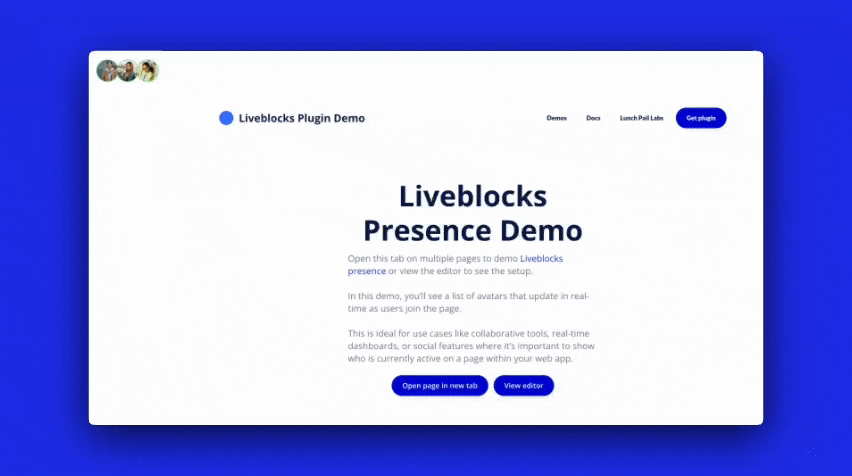
Prerequisites
1. Install and set up the plugin:
If you haven’t already installed the Liveblocks plugin, you can find a step-by-step guide here.Database
2. Set up the database
In this demo, we’ll display users that visit the page. To do this, we need to update theUser data type in the database by adding a name and a profile image.
Go to the Data tab and create two new fields:
nameof typetextprofile imageof typeimage

3. Update the privacy settings
For this demo, we’ll make the user data public to avoid setting up a login system. Go to the Privacy tab and checkView all fields and Find in searches for everyone.
⚠️ In a production app, be more careful with privacy settings to protect user data.

4. Add Sample Data
Finally, add some user data. You can copy the CSV file and upload it into Bubble if you have a paid plan or trial, or manually add at least three users for this demo. For convenience, here is a folder with the photos if you are manually adding users.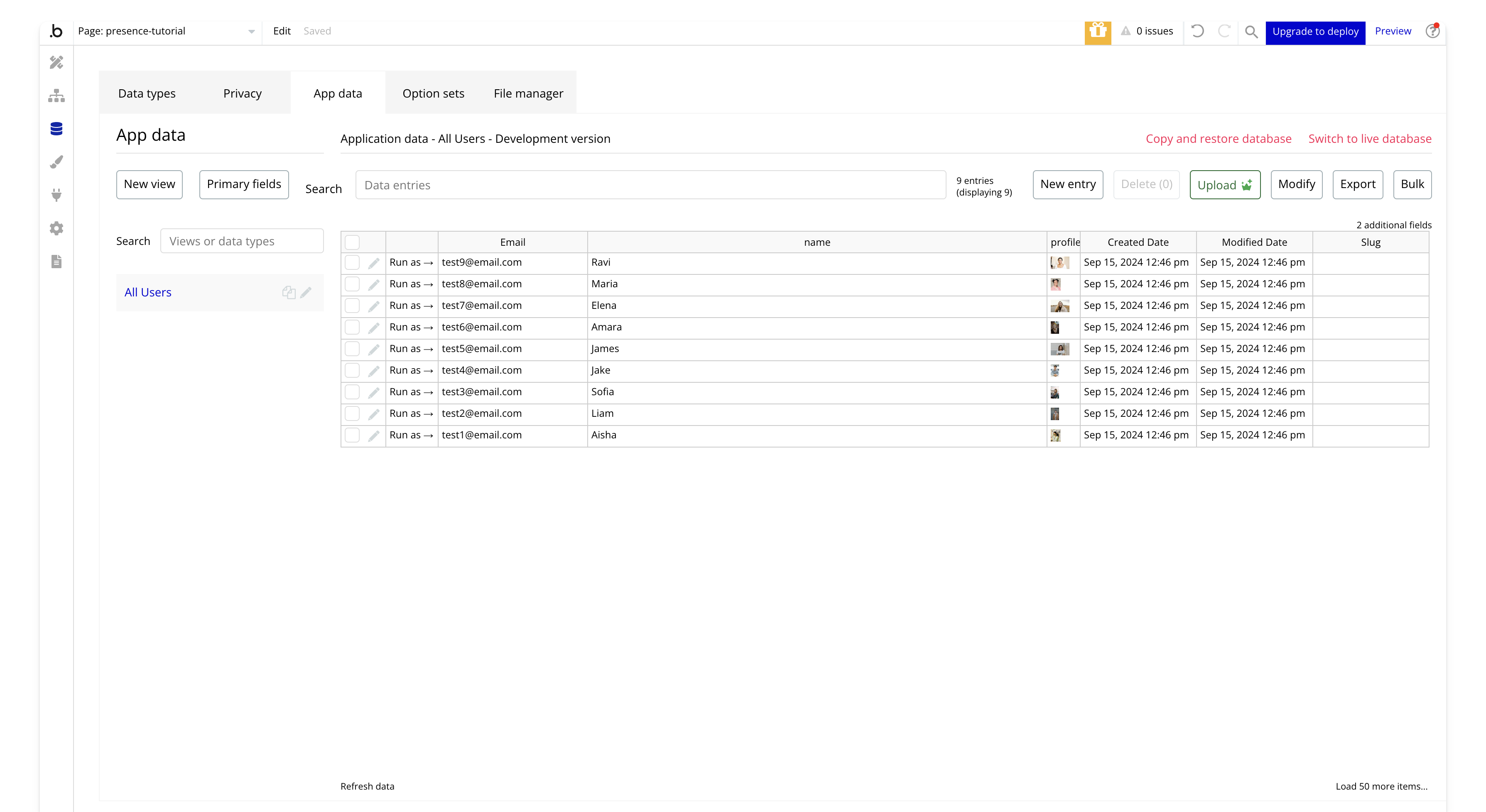
Design
Next is a simple design for the page. While not essential for using presence, it’s needed for the demonstration. If you want to skip ahead to the element setup, jump to the section on adding the presence element.3. Create a New Page
In your Bubble app, create a new page. Give the page a name. For this tutorial, I’m calling it
Give the page a name. For this tutorial, I’m calling it presence-tutorial.

4. Setting up the page
Change the layout of the page. Click on the page until the property editor opens, then go to the Layout tab and selectcolumn instead of fixed.
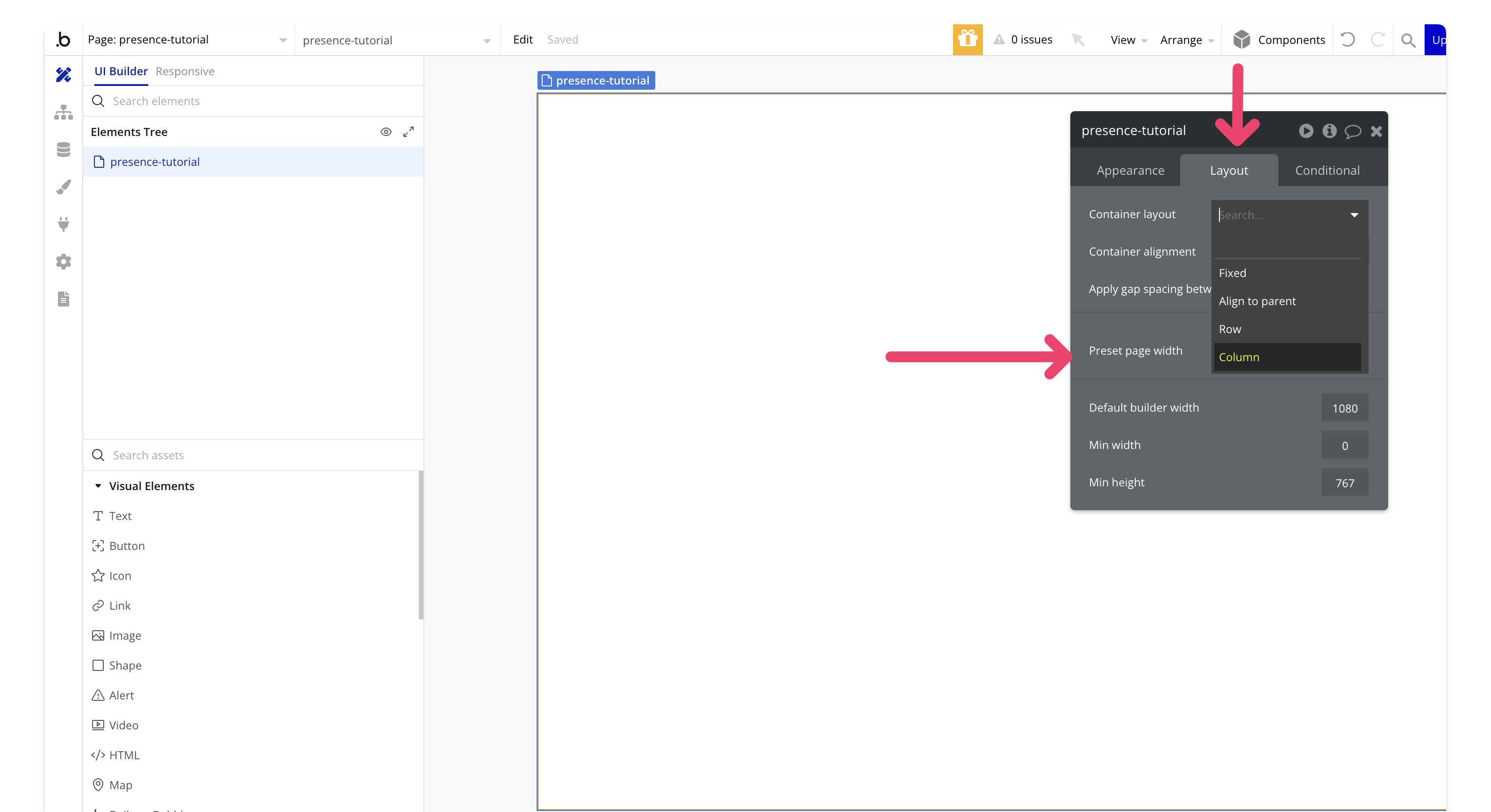
5. Adding the Liveblocks presence element
Add a hidden popup to house the presence element. This keeps it organized and out of the way. Drag a popup onto your page and rename ithidden popup.
 Search for
Search for liveblocks-presence and drag it into the popup to track who’s online.

6. Add a floating group
Create afloating group that will later house our repeating group for avatars.
Search for floating group in your assets and drag it onto the page. In the Appearance tab, set the following:
- Vertically float relative to:
top - Horizontally float relative to:
left - Floating z-index:
above elements
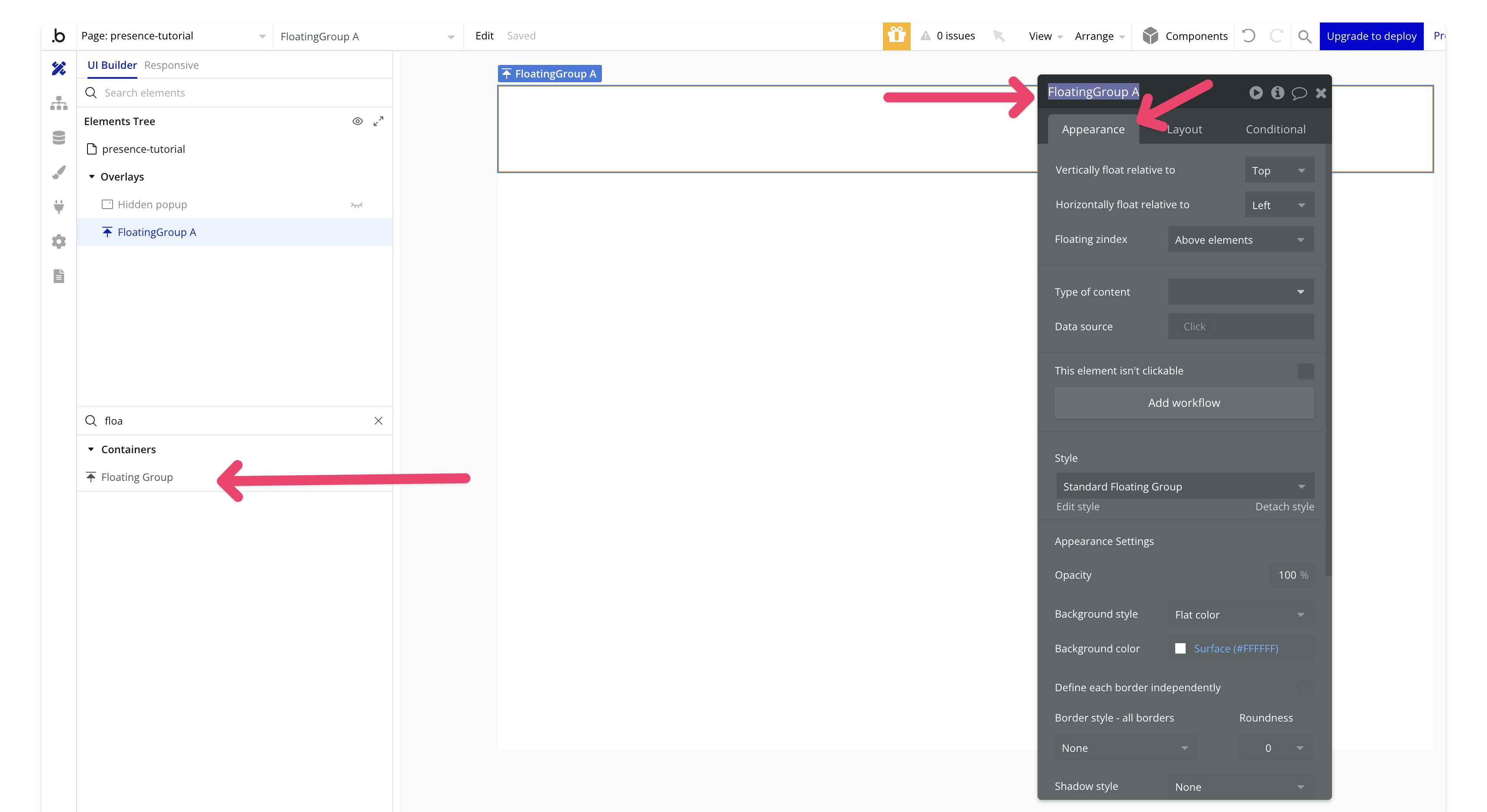 In the Layout tab, uncheck
In the Layout tab, uncheck make this element fixed-width and fixed-height. Set the min-width to 100% and min-height to 100px, then check fit height to content.

7. Add a repeating group
Add arepeating group from the assets to the floating group. Set the type of content to text and the data source to Liveblocks-presence (testing) A's everyone. This data source holds all users in the room, including the local user.
In the Appearance tab, set the following:
- Check
set fixed number of rows - Set
rowsto 1 - Uncheck
set fixed number of columns - Set
minimum width of the columnto 20% - Set
separatorstonone - Set
bordertonone
 In the Layout tab, set the following:
In the Layout tab, set the following:
- Set
cell's container layouttocolumn- Set
container alignmenttotop
- Set
- Check
element is visible on page load - Uncheck
make this element fixed-width - Uncheck
make this element fixed-height - Set
min heightto 0 - Check
fit height to content
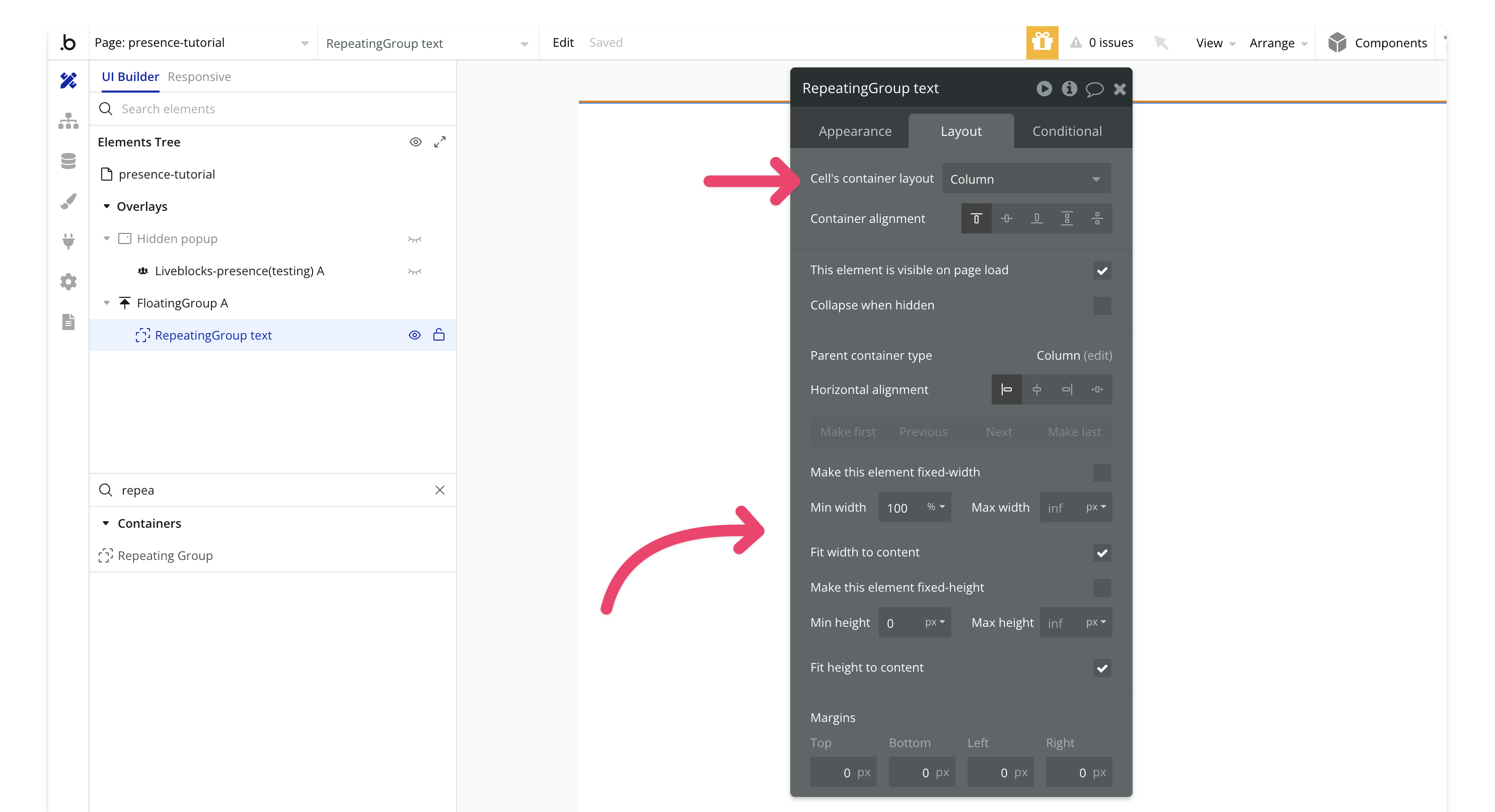
8. Create the avatar
Create agroup user that will display the profile image of users when they are on the page.
Add a group to the repeating group, name it group user, and set the type of content to user.
 Set the data source to
Set the data source to do a search for, make the type user, and set the unique id to current cell's text. This data source is a list of user IDs (which we’ll set later), matching Bubble’s unique IDs.
 Add an
Add an image element to the group user and set the image to Parent group's user's profile image. Enable Imgix and the following settings:
- Check
auto enhance the image - Set
qualityto 100 - Check
resize to fit dimensions by cropping - Check
apply a circle/ellipse mask
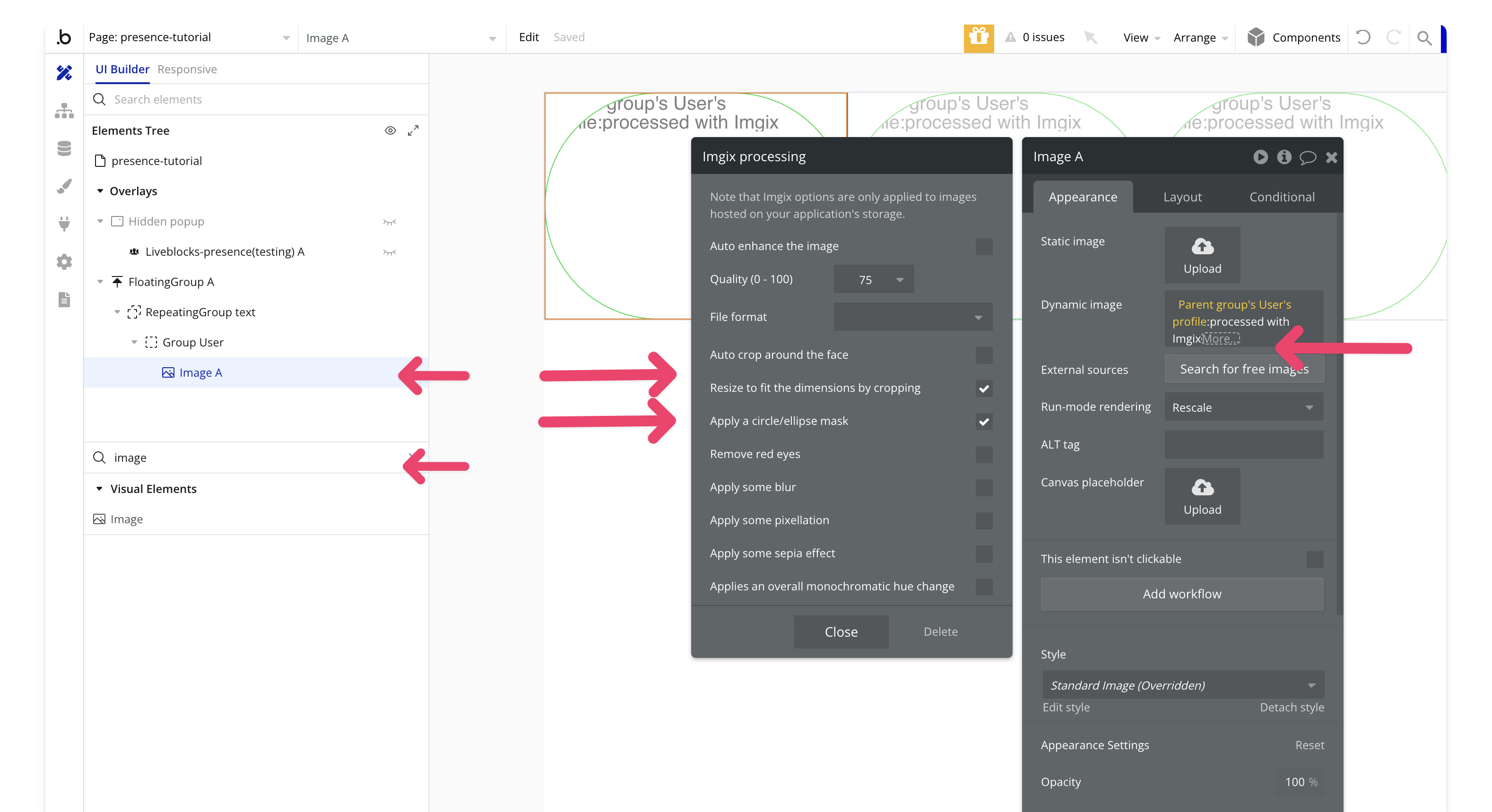 Add a border with
Add a border with solid color #177db4e and set a tooltip to display the parent group's user's name.
 In the Layout tab, set the width to 50px, check
In the Layout tab, set the width to 50px, check keep element aspect ratio fixed, and set the aspect ratio to 1x1.
 That’s it for setting up the design!
That’s it for setting up the design!
Workflows
Workflows are where most of the interaction with Liveblocks will happen.9. Create a room
Create a workflow that runs on page load to create a room for the demo. On page load, add theLiveblocks - create room action. Set the Room ID to tutorial and the Default Access to public.
Add a new event: When page is loaded.
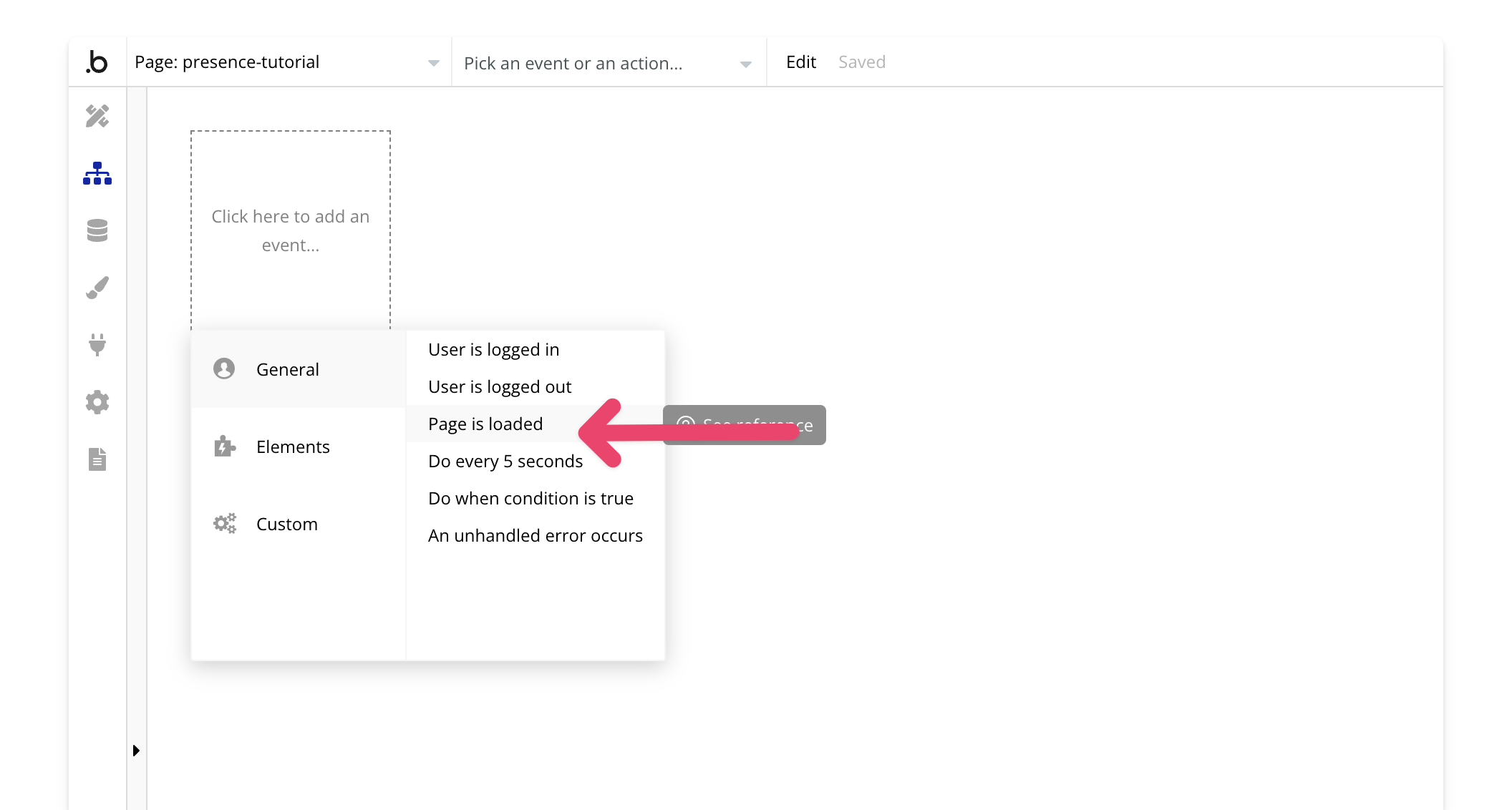 Then add the
Then add the Liveblocks - create room action.
 Add the Air Alert plugin for confirmation. We’ll use it to show an alert with the room name after the room is created.
Add the Air Alert plugin for confirmation. We’ll use it to show an alert with the room name after the room is created.
 Preview the page to confirm that the room was created successfully.
Preview the page to confirm that the room was created successfully.
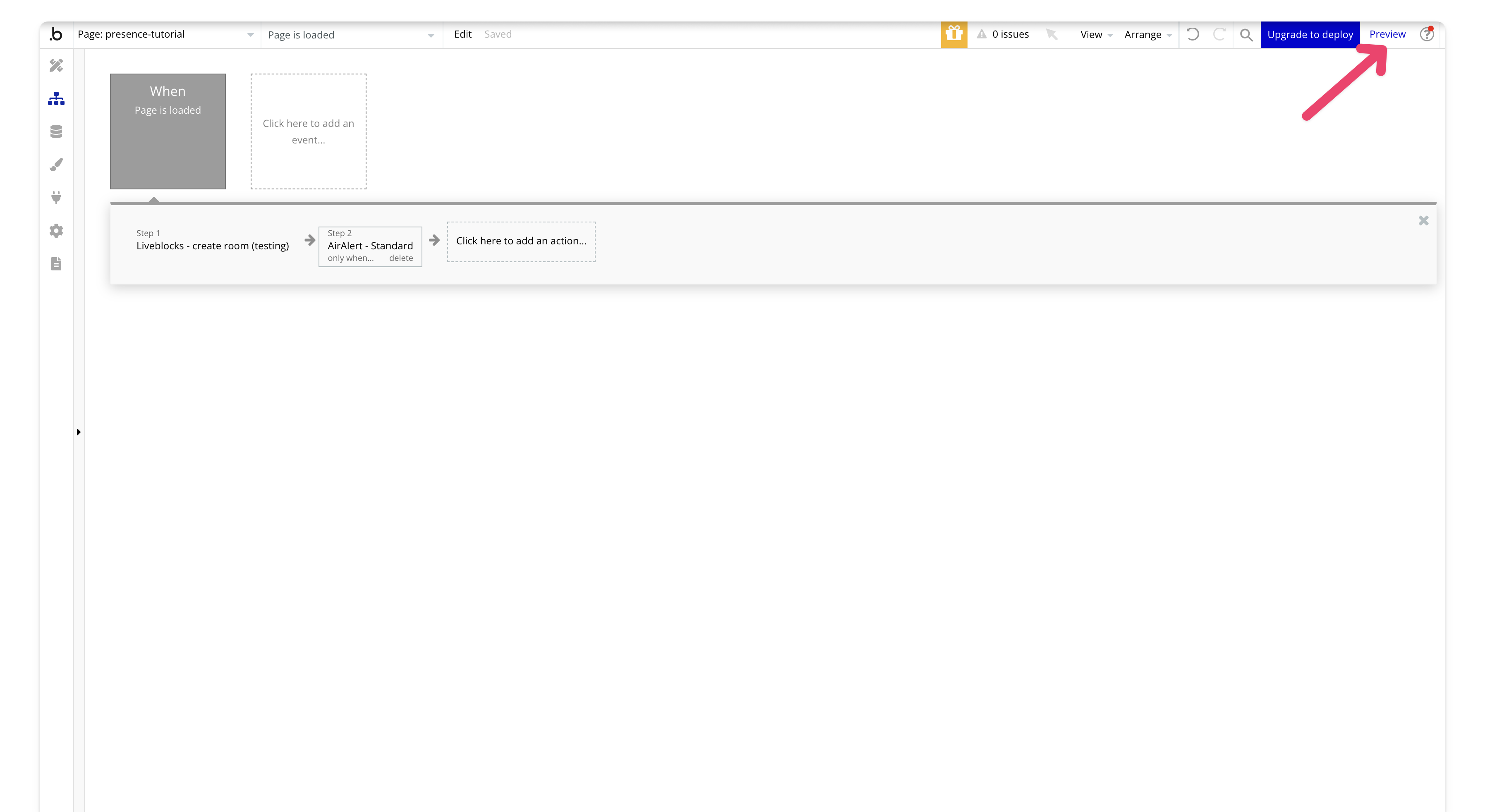 Great! Now that the room is created, we can move on to entering the room.
Great! Now that the room is created, we can move on to entering the room.
10. Workflow to enter a room
You can now disable theon page load workflow—we won’t need it anymore since our room is created.
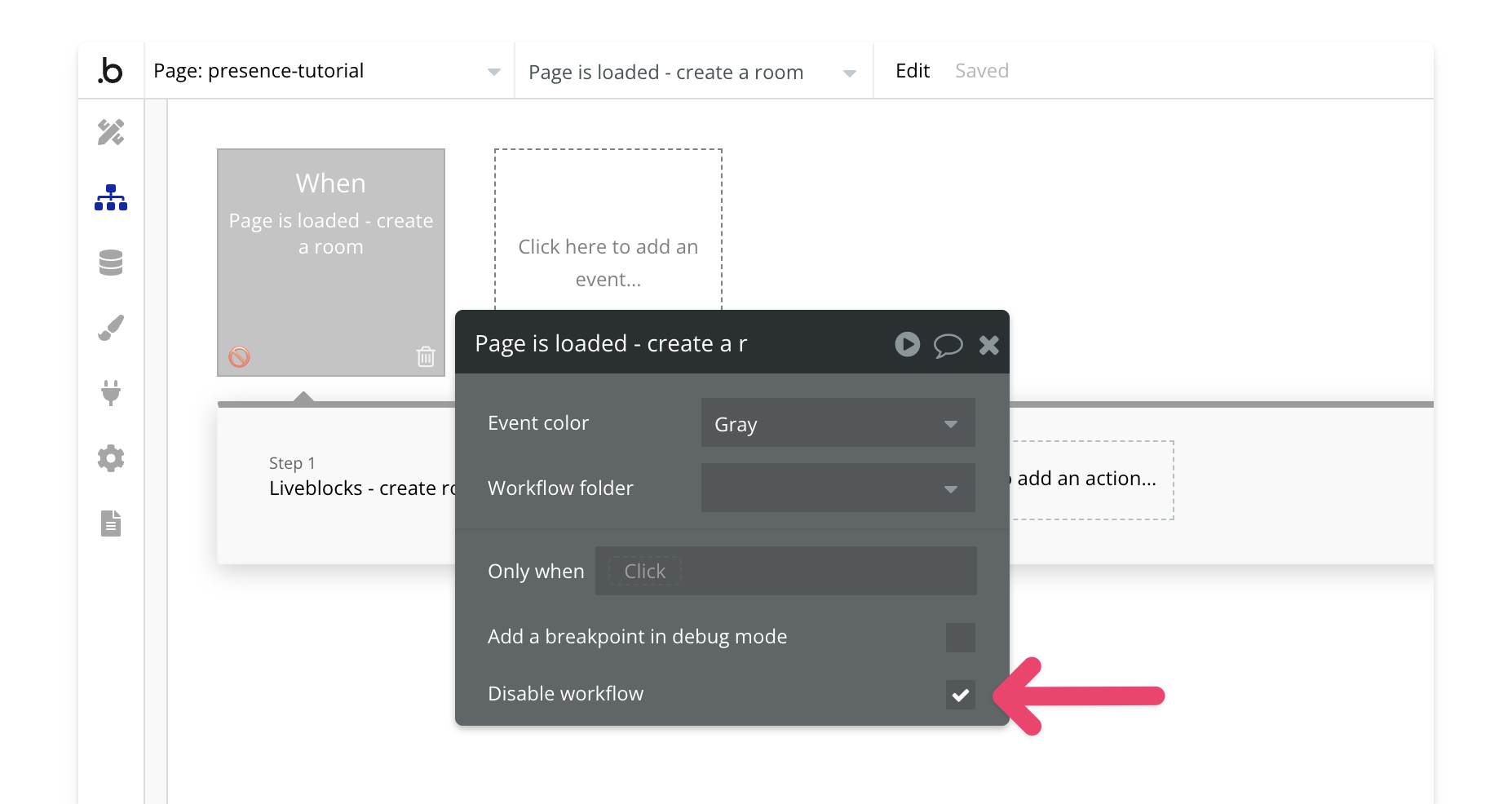 Create a new
Create a new page is loaded workflow. We will add an action to set the state of an element. In Bubble, states allow you to store information within elements. For this demo, we’ll use states to store a random user ID from our database to simulate a random user. In a real production app, you’d use the current user’s unique ID, but we’re avoiding login for this tutorial.
Add a new action to set the state of an element:
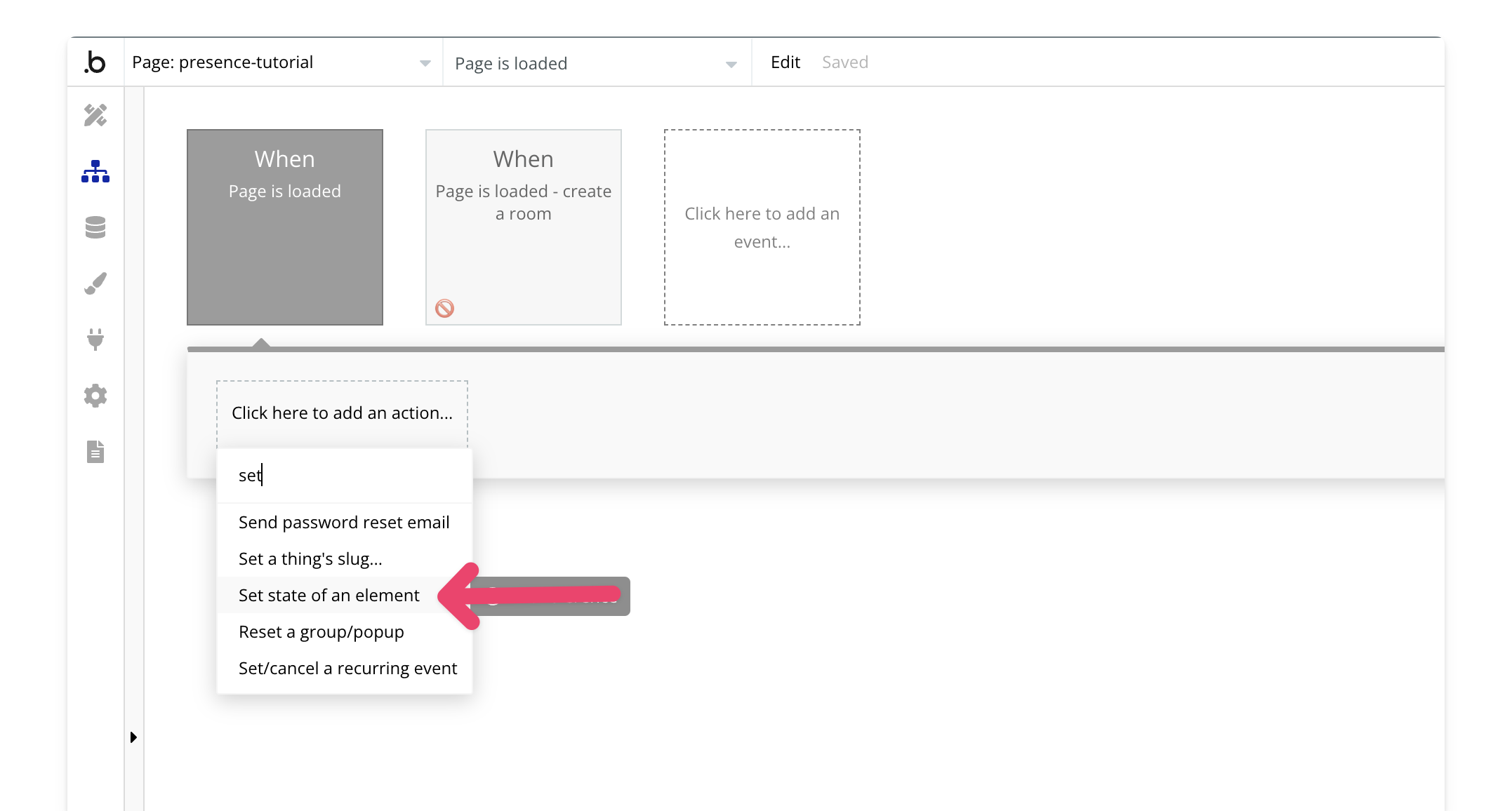 Set the element in the action’s property editor to
Set the element in the action’s property editor to presence-tutorial, then create a new custom state:
 Call the state
Call the state User ID and make it of type text.
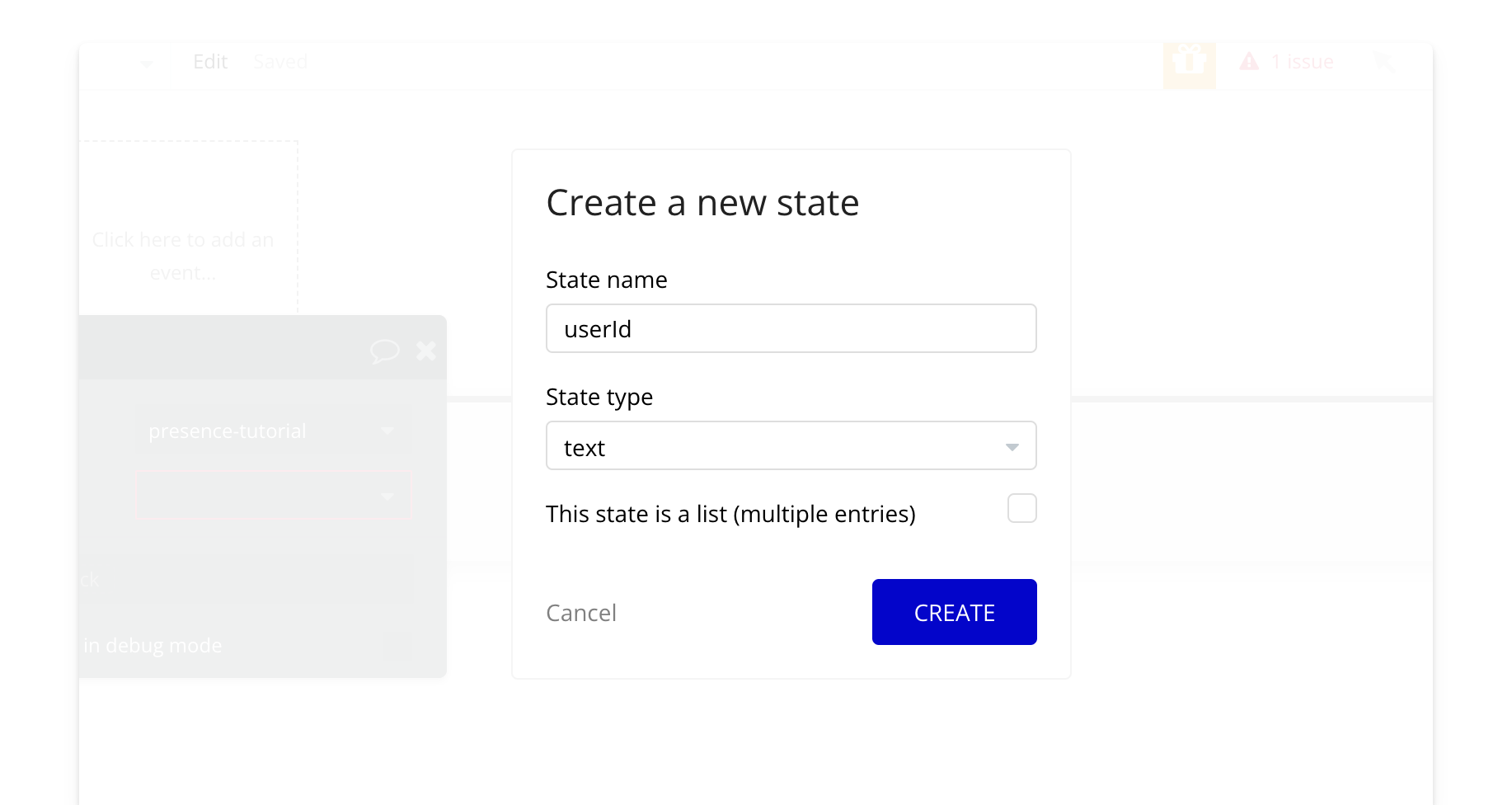 Add an action to set the state of the element to a random user ID.
Add an action to set the state of the element to a random user ID.
 Add the
Add the authorize user action—this authorizes users in Bubble with Liveblocks.
- For the
user IDfield, use theUser IDstate we just created. - For the
Room ID, use thetutorialroom you created. - Set
permissionstoFULL_ACCESS.
 Add the
Add the create client action—this creates an instance of Liveblocks in Bubble. The ID token is the result of the user you just authorized. You can leave throttle and lost connection time as is. Learn more about the parameters of the create client action here.
 Add the
Add the enter room action. This is what joins the user in the room. Enter the Room ID and User ID, and keep the rest as default. Learn more about the advanced settings (e.g., live cursors) in this tutorial.

Demo
11. Trying it out
Selectpreview and you should see the page load with your avatar at the top. Open several tabs to see the users on the page update in real time!


